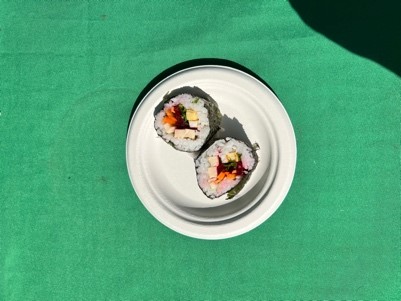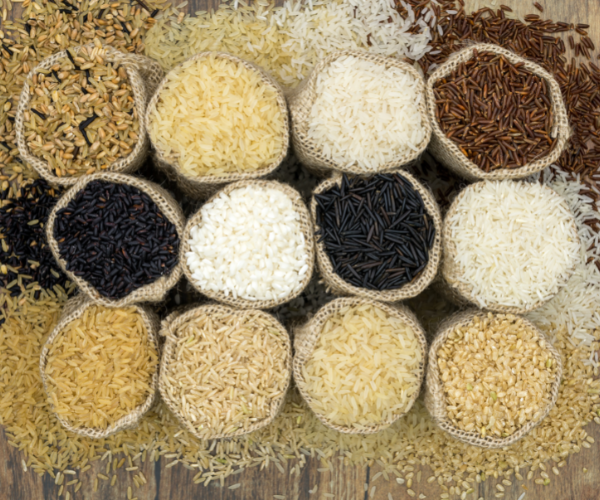"My Korean ancestors would smite me where I stand today if I tried to use brown rice in gimbap. So, we are using white rice.”
 This is how I opened my culinary demonstration at the Green City Market, a Chicago non-profit-run farmers’ market in September. I was making gimbap, a Korean seaweed rice roll utilizing produce and proteins bought directly from the farmers, along with ingredients I’d bought at the Asian markets in Uptown just a few hours before.
This is how I opened my culinary demonstration at the Green City Market, a Chicago non-profit-run farmers’ market in September. I was making gimbap, a Korean seaweed rice roll utilizing produce and proteins bought directly from the farmers, along with ingredients I’d bought at the Asian markets in Uptown just a few hours before.
 Of course, I got the question from an audience member later after I introduced myself as a registered dietitian: “What about using brown rice?” I could feel all the Korean grandmothers twitch a little in their graves; I could feel my eyelid twitch just a little on my face. I do like brown rice (if cooked well) and as a registered dietitian, all the textbooks and courses instinctively categorize brown rice as better and as what should be pushed onto people over white rice. However, is it really the golden child? Is white rice really the black sheep of the family? Let’s see how they go head-to-head in this battle.
Of course, I got the question from an audience member later after I introduced myself as a registered dietitian: “What about using brown rice?” I could feel all the Korean grandmothers twitch a little in their graves; I could feel my eyelid twitch just a little on my face. I do like brown rice (if cooked well) and as a registered dietitian, all the textbooks and courses instinctively categorize brown rice as better and as what should be pushed onto people over white rice. However, is it really the golden child? Is white rice really the black sheep of the family? Let’s see how they go head-to-head in this battle.
Nutrition
Most sources of nutrition information will point towards brown rice as being more nutritious. It has more fiber, vitamins, and minerals such as iron, magnesium, and copper. This comes from the fact that brown rice is rice before the bran and germ (outer shell of the grain) is removed. However, it’s important to note that the difference in fiber between white and brown rice is just one gram (and other differences in vitamins and minerals are negligible as well) and that those nutrients are quickly replaced and supplied by the other foods you’re pairing with rice. Additionally, some of these vitamins and minerals are more easily digestible in white rice because it has less fiber to inhibit absorption in the body. So, while there’s no denying that brown rice (and whole grains in general) has many health benefits, including reducing cholesterol and the risk of type 2 diabetes for instance, that doesn’t mean that white rice has no nutritional value or that it’s harmful or wrong to eat.
Culture & History
Rice has been a staple in human history for millennia. While milling, or removing the bran from rice, wasn’t the starting practice of preparing rice in our diets, it has still been around for hundreds of years and plays important roles in different countries’ histories, symbolism, and food cultures, from being the currency of wealth in Japan to creating space and work for local artisans at rice granaries in Indonesia to becoming a national rice and beans dish from the combination of cultures with Afro-Caribbean migrant railroad workers in Costa Rica. The reason why we don’t get our entire nourishment from powders and pills is because food is enjoyable, it’s there when we celebrate, it’s there when we’re sad, it’s there as a tradition, it’s there as a new experience to try. Whether it’s brown or white, it’s symbolizing not only other people in our lives, but ourselves and our personal identities and this also plays into our health long-term.
Taste & Uses
One of the main reasons people have turned to white rice over brown rice? The taste. It simply tastes better, which means we’re less likely to stop eating it long-term as can happen with brown rice. White rice also performs differently in dishes, typically absorbing and highlighting much more of the flavor of the dish while brown rice can overpower. Another function comes down to texture. Rice has two types of starches, amylose and amylopectin. Amylose is a long, straight molecule that doesn’t gelatinize while cooking, which means that rice with higher ratios of amylose will be fully separated and fluffy (think long-grain rice varieties like Basmati and Jasmine rice). Amylopectin is a highly branched molecule, meaning it has more ends sticking out that can stick together, aka many of our sticky rice or short-grain rice varieties. Because brown rice has more amylose, it’s not the best variety for the types of dishes that use the stickiness of certain types of rice, such as sushi, gimbap, rice pudding, etc. These dishes would fall apart, literally, if white rice wasn’t eaten.
Winner?
It depends. Brown or white rice can be the winner depending on what meal, setting or goal someone has in mind. If you hate the taste of brown rice and want a long-term way to eat rice bowls topped with beautiful veggies and salmon? White rice. If you want to add a whole grain one day because it makes you feel more full and satisfied? Brown rice. If you want to honor your history, experience part of a culture, and make delicious gimbap? White rice.
The point is, there is no “winner” or “loser.” Food is food; it’s simple yet complicated, combined with other foods that provide us nutrition and satisfaction, representing entire cultures and individual memories, and ultimately, serves us in more ways than we think, so why limit or force ourselves when we can enjoy and explore variety throughout our lives? The winner of this battle? Us. Because we get to eat rice, brown or white, or both.
The Chopping Block features different types of rice in these upcoming classes:
- Sushi Workshop featuring perfectly seasoned sticky rice
- An Evening in New Orleans featuring Dirty Rice with Andouille Sausage
- Fall Dinner Party featuring Wild Rice with Dried Apricots, Cranberries and Hazelnuts
- Virtual Beef and Broccoli Stir Fry featuring steamed rice with the stir fry













